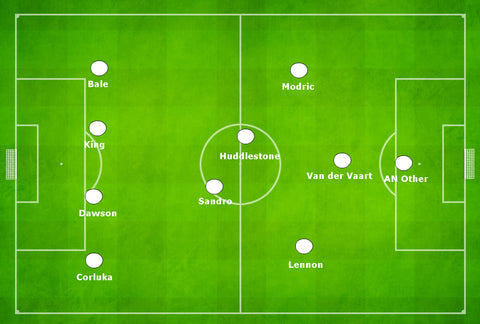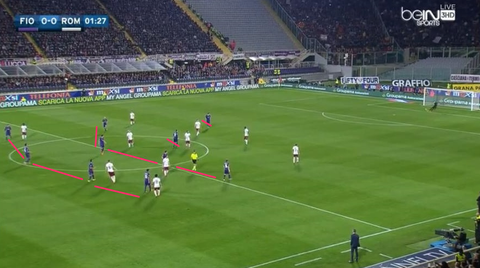Strengths and Weaknesses of the 4-4-1-1 Formation

Make sure to take our Soccer Quiz to see if you, your player or child has what it takes!
The 4-4-1-1 isn’t one of the most commonly used formations in the world, but it has picked up steam in recent years. Managers like Sir Alex Ferguson and David Moyes have had a ton of success with it since it creates mismatches on offense and is more than capable of stopping other formations on defense.
The 4-4-1-1 formation is very similar to the famous 4-4-2, but it is quite different up front. Rather than having to out-and-out strikers, one stays forward and the other is a creative player looking to find openings. Coaches will use this formation over the 4-4-2 when they have a creative player who also happens to be a good goal scorer.
Before managers decide to have their teams play in the 4-4-1-1 formation, they have to know its strengths and weaknesses….
Make sure to take our Soccer Quiz to see if you, your player or child has what it takes!
Strengths of the 4-4-1-1
The 4-4-1-1 has grown in popularity over the last decade because it has multiple ways to beat teams. Below you will find three of the reasons why this is a formation that so many coaches have turned to.
Simple to Learn
Like the 4-4-2 formation, the 4-4-1-1 has a pretty low learning curve. Unlike many other popular formations, this one has most players stick to their zones, which means that they don’t have to cover as much ground throughout the game. It also means that they will have an easier time knowing where they need to be both on offense and defense.
Balanced

Teams that play the 4-4-1-1 usually have an equal focus on offense and defense, which potentially means that they will play well on both sides of the ball. Depending on which formation they are facing, they can often dictate how the game is played, giving them a slight advantage from the start.
Coaches that run the 4-4-1-1 will try to get their teams to be comfortable with and without the ball. Since players are spread out in this formation, they should be able to stay back and keep the opposing team from getting good opportunities, or they can take control of the game and play possession soccer.
Everyone Is Involved

It’s not essential that teams get all of their players involved offensively and defensively, but it does usually lead to better team chemistry. The 4-4-1-1 has every player moving at all times to both be available for the ball and to defend if possession is lost.
When every player feels like he or she has an important part to play, it greatly increases team chemistry and can often lead to good results. There aren’t too many players who don’t enjoy playing in the 4-4-1-1 formation.
Make sure to take our Soccer Quiz to see if you, your player or child has what it takes!
Weaknesses of the 4-4-1-1
Like every other soccer formation out there, the 4-4-1-1 can be exploited. Below are just a few of the main weaknesses of the 4-4-1-1 formation.
Relies on Consistency from the Front Two

The two players that absolutely have to be on their game while playing in the 4-4-1-1 are the striker and the creative striker / trequartista. If they aren’t, then there is a very low chance of the team scoring since the midfielders won’t be moving forward as much.
The 4-4-2 is a bit more forgiving because both strikers are always up the field and other players can get involved in front of goal. While playing in the 4-4-1-1, the trequartista needs to find a way to get the ball and the striker has to find a way to get open in front of him / her. When it works, this is a tough tandem to stop. When either or both players are off, the offense can shut down.
A Little Bit Weak Centrally
Even though the central midfielders have less to do offensively than they do in the 4-4-2, it’s still very easy for them to be overwhelmed defensively. Keep in mind that most of the offensive work is done down the sidelines in this formation, which means that the central midfielders will often be left alone to deal with every opposing central attacker.
Teams that run the 4-4-1-1 will often have to adjust if they are facing a team that likes to attack down the middle, but that means they have to change the core philosophy of the formation. It also doesn’t completely eliminate the counter down the middle since they still have to have the full backs and side midfielders move up the field on offense.
Full Backs Can Get Stuck Up Field
Since full backs in a 4-4-1-1 need to support their side midfielders, it’s very easy for them to leave a lot of space behind them. This can lead to mismatches and gaps between the other defenders. The opposing team’s chances of scoring go way up when that happens.
Even the best full backs get caught up the field from time to time regardless of the formation, but those that play in the 4-4-1-1 have to be more cautious. They don’t want to avoid going forward, but they also don’t want to take too many chances. A full back that is not used to this formation might have a tough time adapting and could make multiple mistakes per game when they are first getting used to it.
Make sure to take our Soccer Quiz to see if you, your player or child has what it takes!


